Over the years, the United States has produced many remarkable generals and admirals, but only a few have stood out as world-class strategists and leaders of troops. As Veterans Day approaches on November 11, let’s remember and celebrate them. Here is my list of America’s finest 11 commanders.
Chester W. Nimitz, 1885 – 1966 (World War II)
Few admirals in history have been faced with a more daunting and unenviable mission than was the former submarine driver Admiral Chester Nimitz upon taking command of a decimated Pacific Fleet in the still smoldering wreckage of Pearl Harbor in December of 1941. He arrived to find a devastated and demoralized anchorage, still reeling from the surprise attack that saw four battleships sunk and four damaged, along with several shot up cruisers and destroyers, some 300 aircraft destroyed or damaged, and over 2,400 killed and another 1,100 wounded. All across the Western and South Pacific, the rampaging Japanese were sweeping aside or capturing Allied armies in the Philippines, Wake Island, the Dutch East Indies, and Malaysia.

Admiral Chester Nimitz. Courtesy: Naval History and Heritage Command.
Following the devastating raid on the fleet’s main base in Hawaii, Nimitz was down to just four fleet carriers and a handful of support craft with which to do battle with a seemingly invincible Imperial Japanese Navy (IJN), currently at the height of its power.
Nimitz brought the right background, personality, intellect, and confidence to the position. Despite calls for a major shake-up after the Pearl Harbor debacle, Nimitz kept his predecessor Admiral Husband E. Kimmel and most of his people where they were, encouraging them to learn from their mistakes. Arriving in Hawaii three weeks after the attack, the taciturn admiral set about rebuilding the fleet and winning the war.
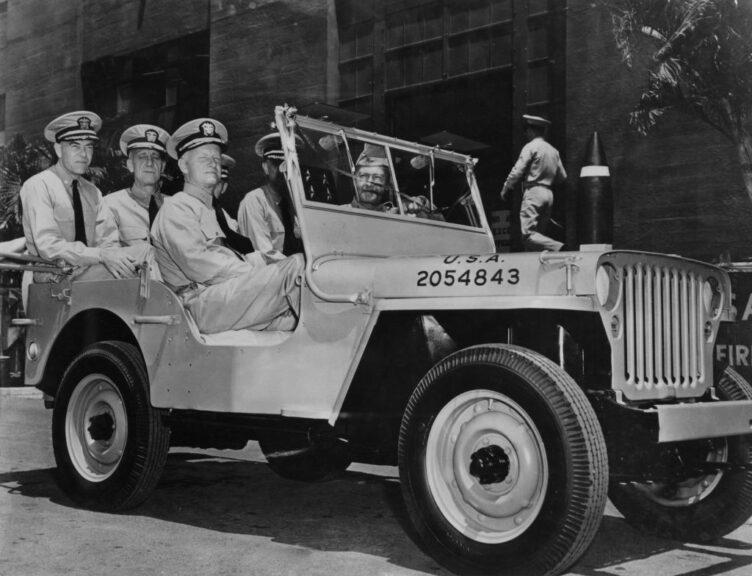
Admiral Chester William Nimitz (1885 – 1966, centre), the Commander-in-Chief of the US Pacific Fleet, takes a ride around Pearl Harbor in Hawaii with his aides-de-camp, in a jeep presented to the fleet by the Hawaiian department of the US Army in honour of their naval victory at Midway Island, January 1942. (Photo by Three Lions/Hulton Archive/Getty Images)
The first serious challenge facing the new CINCPAC (Commander in Chief Pacific Fleet Headquarters) came from his Navy codebreakers. They alerted Nimitz of two impending Japanese operations, one to capture Port Moresby on New Guinea near the Coral Sea and the other on Midway Island, 1,300 miles west of Oahu. The reserved Nimitz was unfazed. As the Coral Sea threat came first, Nimitz dispatched a task force built around his two available carriers, Lexington and Yorktown, (the other two, Hornet and Enterprise, were still returning from the Doolittle Raid in April) to try and prevent the landings on Port Moresby, just 300 miles across the water from mainland Australia. Although the Battle of the Coral Sea in May 1942 — the first naval battle fought entirely by aircraft — was a tactical draw, with each side having one carrier sunk and another severely mauled, the Japanese invasion plans were thwarted. It was the first U.S. naval success of the war.

CINCPAC staff, May 1944. Courtesy of Fleet Admiral Nimitz. Naval History and Heritage Command.
Coral Sea, however, was the warm-up act for the showdown to come in June 1942. Nimitz was confronted by a massive flotilla of IJN warships bearing down on the tiny Midway Atoll. CINCPAC’s Japanese nemesis, Adm. Yamamoto Isoroku, planned to lure the remainder of the U.S. Pacific Fleet out of Pearl Harbor with a surprise attack on Midway. There he would destroy the Americans with devastating air attacks launched from four premier carriers at the heart of the mobile task force. Yamamoto would then finish off any surviving U.S. vessels with the guns of the mightiest surface fleet ever assembled up to that time. But Nimitz’s code-breakers were aware of the Japanese battle plans, and so he planned an ambush of his own. Here was where his quiet but firm demeanor paid dividends.
When he was informed that it would take three months to get the heavily damaged Yorktown back into fighting trim, Nimitz simply said, “We must have this ship back in three days.” (After a long silence, hull repair expert Lt. Commander H.J. Pfingstag gulped and said “Yes, sir.”) Within seventy-two hours Yorktown, and her complement of some 90 invaluable aircraft, was sailing out of Pearl Harbor to join Hornet and Enterprise for the surprise attack. Meanwhile, Nimitz was sending every spare aircraft and box of ammunition he could find to bolster up Midway’s defenses. The hunted were now the hunters.
Opting to command from Hawaii to have greater overall control, Nimitz instructed his subordinates at sea, Adms. Frank Jack Fletcher and Raymond Spruance, to utilize the principles of “calculated risk.” In other words, be careful, but if you see an opportunity to land a blow, take it. In short, the calm, prematurely gray Texan was a gambler at heart, if no fool. Several critical decisions faced him in the coming days. For one, the first sighting of Japanese ships was not Yamamoto’s carriers but rather a landing force headed for Midway.
Trusting in his intelligence, Nimitz instructed Fletcher and Spruance to ignore the tempting target and await the carriers which he expected to emerge from a stormfront hundreds of miles away. Not an easy decision to make. But it turned out to be the correct one. Here Nimitz displayed one of his most valuable command traits — confidence in the abilities of his subordinates, in this case, his intelligence staff.

Grumman TBF-1 Avenger anti-submarine torpedo plane in flight over the Pacific, 1944 or 1945. The Avenger made its maiden flight on August 1, 1941 and participated in the battle of Midway (June 1942). (Photo by: Photo12/Universal Images Group via Getty Images)
On June 4, 1942, Navy and Marine fliers swarmed down on the unsuspecting Japanese and blasted all four of Yamamoto’s fleet carriers out of the water. Understanding he was still heavily outgunned, Nimitz wisely kept his much smaller flotilla out of range of Japanese surface vessels, denying them any chance to change the outcome of the one-sided victory. Having lost air superiority, Yamamoto was forced to retreat. Midway was, in fact, one of the most stunning turning points in the history of naval warfare. And although many hard-fought battles with the IJN in the Solomons were to come, in six months Nimitz had wrested the initiative from the Japanese. And he never gave it back.
From there, Nimitz, in command of Central Pacific operations and working with surprising ease alongside his Army counterpart General MacArthur in the South Pacific, methodically built up his offensive strength. Starting with landings on the Gilbert Islands in November 1943 and culminating in the Ryukyus in April 1945 — an operation whose size and scope rivaled the Normandy landings — he orchestrated a series of island hopping campaigns that brought the U.S. closer and closer to mainland Japan, while destroying the IJN along the way.
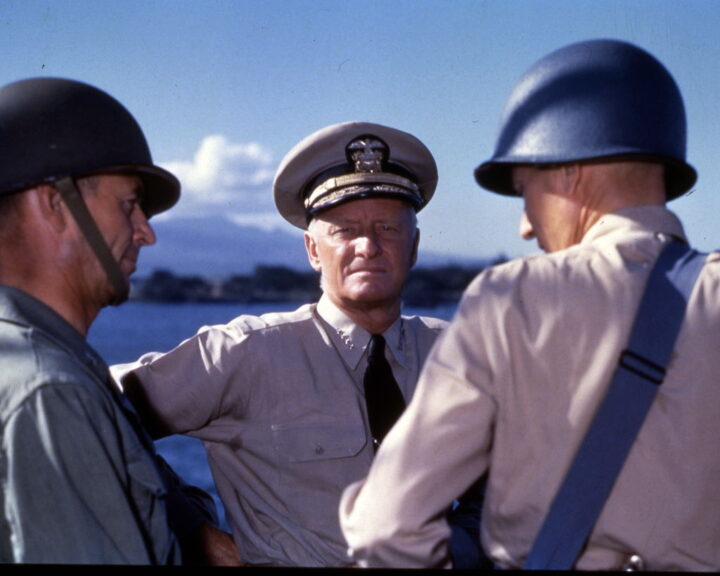
American military commander Admiral (and later Fleet Admiral) Chester William Nimitz (1885 – 1966) discusses strategy for the Gilbert and Marshall Islands campaign with two unidentified others, Pearl Harbor, Hawaii, October 1943. (Photo by PhotoQuest/Getty Images)
Some critics, like MacArthur, believed the Navy’s penchant for completely clearing islands of Japanese holdouts once the airfields were secure led to unnecessary casualties. Nimitz’s defenders, however, would argue that he was fighting for tiny specks of land on which the Japanese defenders had no lines of retreat and so every one of the enemy had to be eradicated or remain a constant threat, as Iwo Jima’s aircrews learned when Japanese continued to raid U.S. bases despite the island being declared “secure.” MacArthur, on the other hand, was fighting on a different landscape featuring giant land masses like New Guinea, New Britain, Leyte, and Luzon on which he could leave the defeated Japanese to fade into the jungles to either die in due time from starvation, disease, or honorable suicide. In both cases, America’s two top military men in the Pacific performed superbly.
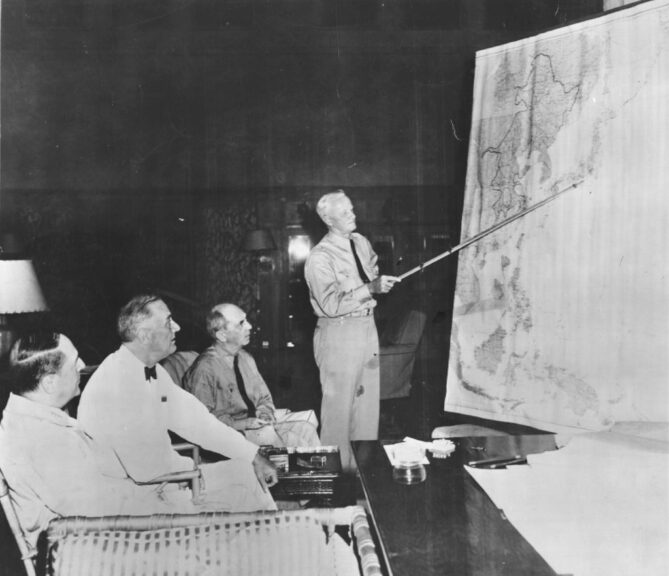
circa 1943: American General Douglas MacArthur (1880 – 1964), President Franklin Roosevelt (1882 – 1945), and Admiral William Leahy (1875 – 1959) at a briefing given by Admiral Chester Nimitz (1885 – 1966) at a map of the Pacific war zone. (Photo by Keystone Features/Getty Images)
While Nimitz was based in Hawaii, he was by no means always absent from the front. Rather, CINCPAC made it a point to visit the combat zones frequently to get a sense of what his men in the field were facing as well as consult with his admirals about how best to proceed. Needless to say, like so many on this list, Nimitz was not averse to placing himself in harm’s way if it helped his understanding of the tactical as well as strategic challenges before him.
Although Nimitz’s performance throughout the Pacific War was stunning, it was not flawless. His decision to move forward with the capture of Peleliu in September 1944, ostensibly to protect MacArthur’s flank while he invaded the Philippines, was a costly miscalculation. MacArthur’s bypassing of Mindanao to fall upon Leyte farther up the island chain made Peleliu’s airfield strategically irrelevant.
Furthermore, the astute Adm. Halsey had recommended calling off the landings and sending the Marines to Leyte instead. But Nimitz overruled him, and land they did. The agonizing 72-day fight for Peleliu turned into one of the ugliest and bloodiest battles of the entire war. Indeed, some 8,000 U.S. Marines and Army troops fell there for minimal return on the investment in blood. However, in Nimitz’s defense, unbeknownst to the Americans, the Japanese island defenders had adopted new, much more effective tactics of attrition, choosing to dig in and await the Americans on ground of their choosing rather than throwing themselves at the heavily-armed enemy in fruitless Banzai charges. As one First Marine Division veteran would offer, “[Peleliu] was the biggest surprise, I think, the Marine Corps received in World War Two.”
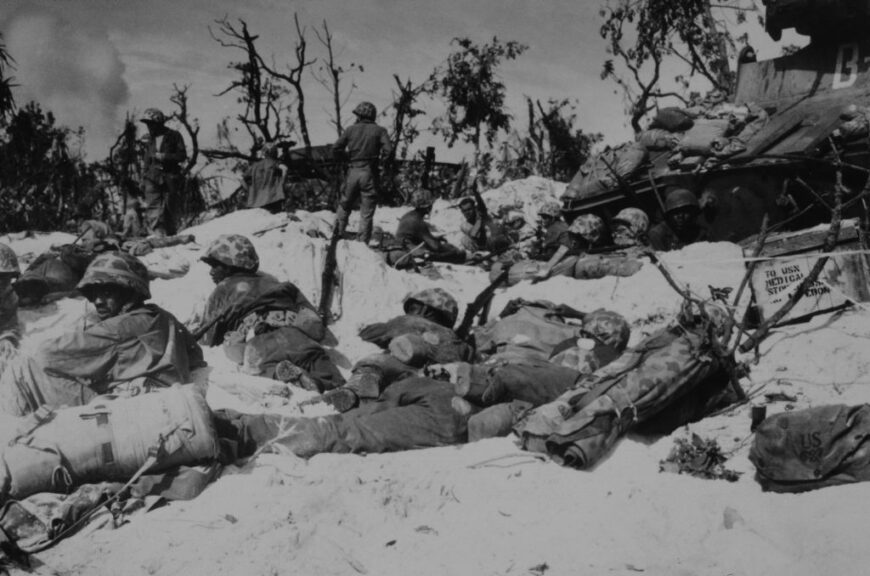
American military officers move across the sands during the Battle of Peleliu (Operation Stalemate II), during the Second World War, on the beach at Peleliu, Palau, 15th September 1944. The troops, supporting the 7th Marines, are either the 16th Marine Field Depot or the 17th Naval Construction Battalion Special. (Photo by Archive Photos/Getty Images)
Peleliu notwithstanding, Nimitz’s ability to effectively manage so large a naval ensemble, to see so clearly both the tactical and strategic situation, to grasp the complexities of the most expansive military theater in history, with tens of thousands of moving parts spread across the vastness of the world’s largest ocean, while practicing the right combination of direct command and delegation, make him arguably the most effective naval man this country has produced.
Like MacArthur, Nimitz intuitively understood the Japanese enemy he faced. Their strengths, weaknesses, and how best to deploy U.S. naval power to win the war. A typical example of Nimitz’s relaxed and confident approach to command, while displaying an innate grasp of the fierce nature of the Japanese fighting man, can be found in his response to Vice Admiral Turner on Okinawa, who optimistically radioed that the landings had been unexpectedly unopposed: “I may be crazy,” Turner said, “but it looks like the Japanese have quit the war…”
In typical Nimitz style, the unimpressed CINCPAC wryly radioed back: “Delete everything after ‘crazy.’”
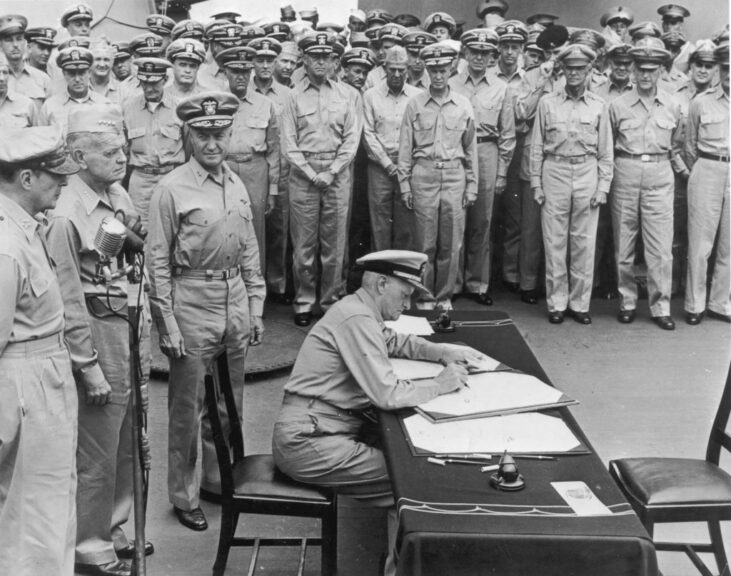
2nd September 1945: US Fleet Admiral Chester W. Nimitz signs surrender documents recognizing the defeat of Japan as officials and soldiers look on, USS Missouri, Tokyo Bay, Japan, World War II. General Douglas MacArthur (left), Admiral William F. Halsey (centre), and Rear Admiral Forrest P. Sherman stand behind Nimitz. (Photo by Hulton Archive/Getty Images)
* * *
America’s Top 11 Generals
* * *
Brad Schaeffer is a commodities trader, columnist, and author of two acclaimed novels. His newest book, the fact-based LIFE IN THE PITS: My Time as a Trader on the Rough-and-Tumble Exchange Floors will be published in December and is currently available for pre-order. You can also find more of Brad’s articles on Substack.
The views expressed in this piece are those of the author and do not necessarily represent those of The Daily Wire.

Continue reading this exclusive article and join the conversation, plus watch free videos on DW+
Already a member?
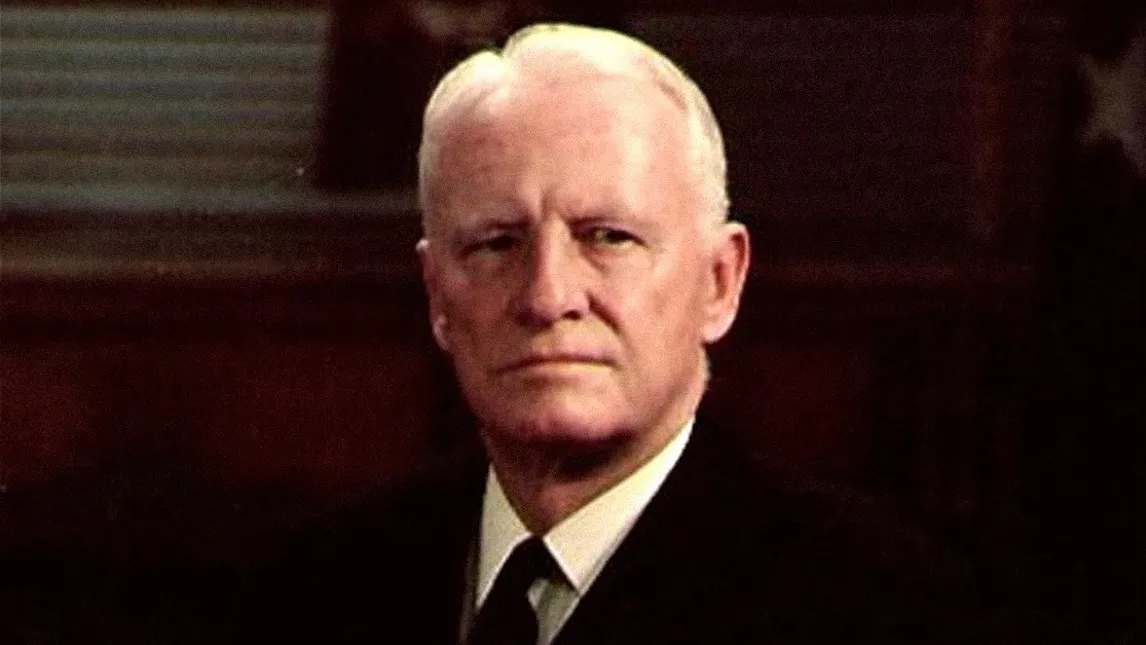
.png)
.png)

